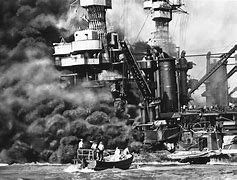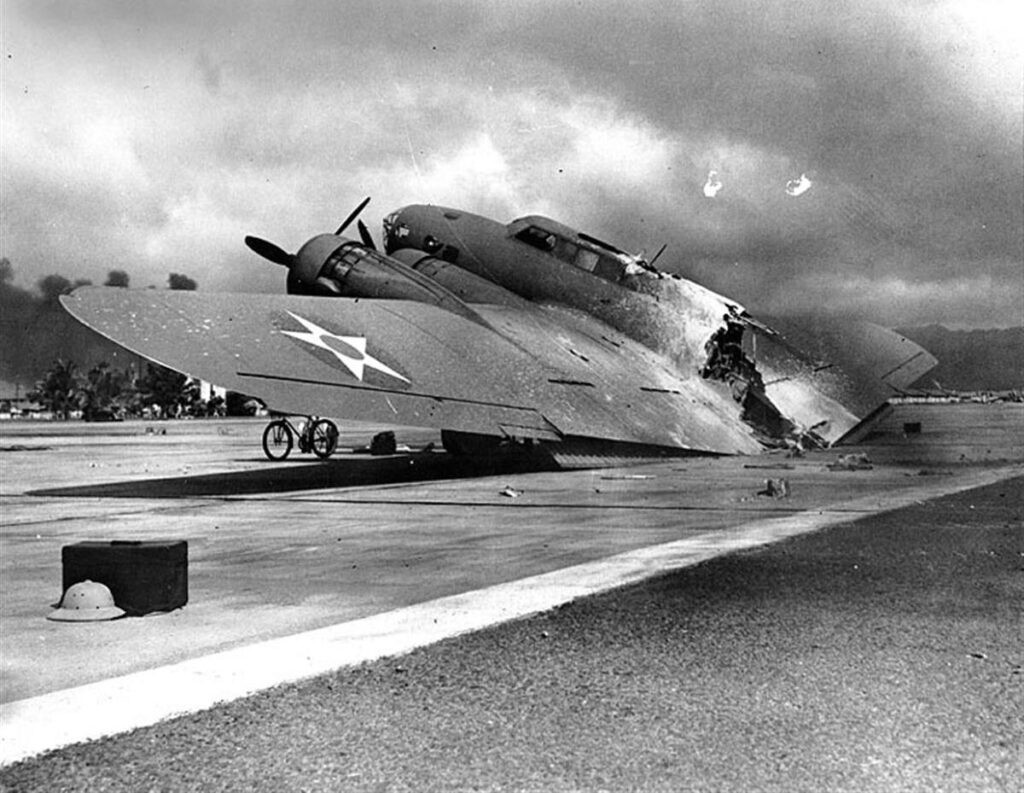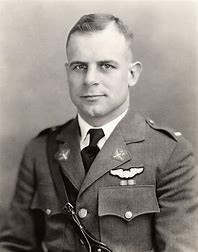Until the beginning of December 1941, the United States was not involved in the war. After the end of WW1, the Americans were not eager to plunge into a war again.
In the 1930s, Japan was overpopulated and had a great lack of raw materials. To satisfy the expansion drive and to get raw materials, Japan invaded China. Japan also joined the Axis Powers (Germany, including annexed Austria, Japan and Italy). The Western powers saw Japan’s expansion as a threat to their own economic and strategic interests. Several embargoes were set up that were considered an unfriendly act in Japan. The diplomatic tension increased and a war was negotiated. During the negotiations, both sides were working on plan B in case the negotiations went wrong. It was clear to Japan that the U.S. fleet would pose the greatest threat to the Japanese navy.

The Japanese Admiral Yamamoto had developed a plan to destroy the U.S. fleet, for anchor in Pearl Harbor on Hawaii’s Oahu Island. He would sail with 6 aircraft carriers with an escort to the naval base on Pearl Harbor. The American ships, which were locked in the harbor, would be an easy target for the carriers’ aircraft. Yamamoto’s plan was approved. While there was still negotiation with the Americans, the Air Force and Navy began practicing on a large scale for an attack. Japanese spies at Pearl Harbor provided detailed information on the number of ships in the port.
The Americans, who always feel invulnerable, did not care about the increased Japanese activities. Signals that something was imminent reached an American top diplomat, Henry Stimson, who tried to warn the homeland of an imminent attack. But the warning was ignored.
On December 7, 1941, the Japanese Navy attacked Pearl Harbor with the carriers’ aircraft. The original plan was first to hand America a declaration of war and then, within half an hour of the statement, to take action. So Japan could not be accused of attacking the U.S. fleet without a declaration of war. The planning went completely wrong. The Japanese diplomats in America received the message too late and could not hand over the declaration of war to the Americans in time. When the Americans received the declaration of war, the first bombs already fell on Pearl Harbor. Yet the Americans had already intercepted and been able to translate encrypted messages. Strangely enough, no action was taken here either.

Pearl Harbor also had adequate radar stations. Indeed, a large number of aircraft were observed, but it was thought that the group of aircraft was a group of American B-17 bombers expected that day in Pearl Harbor. Nevertheless, the report was passed on, but also this time nothing happened. Also, one noticed a mysterious Japanese submarine trying to enter the port of Pearl Harbor. It was thought that the submarine was lost, but a more logical explanation seems to be looking for weaknesses within the American fleet and whether America was prepared for war. At 12.00 the submarine was sunk. The incident was passed on very late to Admiral Husband Edward Kimmel, who then did nothing with it. All the ships were at anchor in the port and were an ideal target for the approaching Japanese aircraft. Kimmel would be relieved, degraded and replaced with Admiral Chester Nimitz 10 days after the attack of his post.
Roosevelt: “December 7 a date which will live in infamy”
At 12:49 a.m., the Japanese pilots officially received permission for the attack. At 12:55 a.m. the first attack was carried out, the second attack took place at 14:00. At 14.45, 18 of the 96 ships had been sunk or badly damaged. 188 of the 394 aircraft had been destroyed at the airfields and 159 others had been damaged. 2402 military personnel were killed and 1178 were wounded. The high number of deaths was mainly caused by the sinking of the battleship Arizona which received a hit right through the deck in the ammunition storage site, resulting in 1177 casualties. But the Japanese could not have taken out U.S. aircraft carriers simply because the carriers were not present in Pearl Harbor on that day. One aircraft carrier had been sent to Midway, two others to another territory. These displacements showed that America was aware of the Japanese threat. It was the same aircraft carriers that would later play a decisive role in the Battle of Midway. But they clearly had not been alert enough.
After the attack, Yamamoto wrote: “I fear all we have done is to awaken a sleeping giant and fill him with a terrible resolve.”
The victim of the attack as far as the large ships were concerned were the Arizona and the Oklahoma, both totally lost, the West Virginia (repaired and deployable again in July 1944), the California (repaired and deployable again in January 1944), the Nevada (repaired and deployable again in October 1942), the Pennsylvania (remained in service), the Tennessee (repaired and deployable again in February 1942) and the Maryland (repaired and deployable again in February 1942). Furthermore, the cruisers Helena, Raleigh, and Honolulu, the destroyers Cassin, Downes, Helm and Shaw and a number of smaller ships. All these ships were repaired and could be deployed again fairly quickly. The Pearl Harbor Naval Shipyard with the help of the Pacific Bridge Company and other civilian companies ensured that within 6 months of the attack, five battleships and two cruisers could sail again and be repaired in the home country.
The fact that Japan and America were now at war was the reason for Hitler (as a member of the Axis Powers) to also declare war on the Americans. The United States was thus again involved in a European war. And, which would turn out later, that was bad news for Japan and Germany.

The Doolittle Raid

The Americans had now woken up and Roosevelt instructed his military leaders to come up with a plan to touch Japan. Not in the belief that an attack would do a lot of damage, but to make the Japanese feel that they too were not untouchable. In addition, America was deeply shocked of what had happened in Pearl Harbor and the moral had to be extended urgently. January 1942 the plan was created to bomb Tokyo. The problem was the distance. The only way to do this was to attack from an aircraft carrier, with the requirement that the aircraft carrier be able to get as close as possible to Tokyo.
Francis Low and James Doolittle were chosen to put together a plan. They quickly came to the conclusion that the only plane that could do the attack was a B-25 “Mitchel” bomber. The B-25 was the only larger aircraft that could take off from an aircraft carrier. With the bomb load on board, the aircraft had to be stripped of all the extras. To achieve the goal, the anti-aircraft gun were removed, as well as the radios and the aircraft were equipped with additional tanks to increase the flight range. On February 3, 1942, Low and Doolittle demonstrated that the plan could work by having two B-25s take off from the deck of the carrier Hornet off the coast of Norfolk.
The attack would be carried out at extremely low altitude (460 meters) and each aircraft would be equipped with 900 kg of fire and high explosive bombs, depending on the target. 140 men of the 17th Bombardment Group were singled out to participate in this mission. Three weeks of intensive training at Eglin Field in Florida followed in flying with the heavy aircraft, night flying, bombarding at low altitudes and navigation without visible landmarks and without radio. Although Doolittle himself admitted that a longer training was recommended, the group left for California in late March.
On 1 April 1942, 16 modified B-25s were loaded onto the Hornet’s aircraft deck. The Hornet left under the guidance of the cruisers Nashville and Vincennes, tanker Cimarron and four destroyers. An encounter would take place with the aircraft carrier Enterprise and would then sail on to a position about 640 km from the Japanese coast, where the B-25s would take off. The deck of the Hornet was full of B-25s, so protection from the air was carried out by the Enterprise’s aircraft. There was fierce discussion about how to carry out the attack. The final decision was to take-off at dusk, bombing the targets during the night and flying on to Quzhou in Zhejiang province in unoccupied China in the morning.
The bombing of Tokyo

The original plan was therefore to take off the planes at 640 km from the Japanese coast. But at 3:00 a.m. on April 18, the Enterprise’s radar discovered a Japanese scout 18 km from the carrier, far beyond the expected patrol area. The ship was quickly sunk, but the position of the Americans had already been passed to the Japanese high command. Admiral William Halsey, leader of the flotilla, did not want to risk his ships by steaming further and gave the order to launch the planes. At that time the Hornet was about 1320 km from Tokyo, much more than the 640 km from the original plan. Positively, the aircraft would be helped by a backwind of 40 km per hour during the last 1900 km of their mission.
Doolittle started first and the remaining B-25s also experienced no problems. The journey to Tokyo went on without any problems. The aircraft tried to avoid as much contact as possible with the various ships and aircraft among them. Nine Japanese warplanes overlooked the bombers 16 km from the target and did not seek contact. Arriving above the target, The B-25s climbed to an altitude of 366 meters, released their bombs and flew west over the suburbs of the city. No aircraft was hit by defense guns. About 14 tons of bombs were dropped on the agreed targets.

The planes flew to the coast of China. When they arrived, the visibility was almost zero and the crews of the B-25s had to rely entirely on their instruments. Doolittle tried to reach Quzhou but was almost through his fuel. Exactly thirteen hours after the departure of the Hornet, Doolittle ordered the plane to be abandoned. All the troops landed safely on Chinese soil. Doolittle asked General He Yangling to look out for the other aircraft and their crew. In the morning of April 20, four more aircraft with their crew were located. But three of the 16 crews were unable to reach Quzhou and Chongqing. One of the aircraft was forced to land at Vladivostok. The crew was detained by the Soviets for more than a year, but were later able to flee to Iran with the help of the NKVD, at that time occupied by the British and the Soviets. Two crews were captured by the Japanese until the end of the war. Robert Meder died of dysentery and Dean Hallmark, William Farrow and Harold Spatz were executed by the Japanese in October 1942. The bombing of Tokyo caused relatively few casualties, also did not really cause much damage, but had a huge psychological effect in the United States and in Japan.
Quzhou is punished
Days after the bombing, the Japanese planned an action to punish those who had helped to bring the Americans to safety. Souvenirs left behind by the Americans out of gratitude, ensured that entire Chinese villages with their residents were wiped off the map in the most horrific way. Japanese bombers bombed Quzhou and Nanchang. An estimated 250,000 civilians were killed during a three-month retaliatory action. After the withdrawal of the Japanese army, the infamous Unit 731 made its entrance into the territories, similar to Hitler’s Einsatzgrüppen.
Unit 731, Japan’s Disturbing Human Experiments Program
Of all the atrocities that Japan let loose on the Chinese population during the occupation, Unit 731’s operations were the most horrific ever shown and on a scale that could have completely destroyed the world several times. Josef Mengele has gone down in history as a Nazi criminal who did many trials on defenseless prisoners until death followed. Compared to the activities of Unit 731, the actions of Mengele and the Einsatzgrüppen are child’s play.

Unit 731 began in 1932 quite innocently as a “research unit on general public health”, but soon resulted in a unit that was engaged in the production of all kinds of germs that, if fully applied, could have killed everyone on our planet several times. All this was built on infinite suffering of the people who were detained as test cases and ongoing germ diffusers until Unit 731 ceased to exist in 1945. The most terrible torture and experiments took place in Japanese-occupied Manchuria. The person who would lead the entire Japanese biological weapons project was the military doctor and bacteriologist Shiro Ishii. Trials with hypothermia, vivisection, prisoners who were used alive how efficient firearms and bayonets were, how long victims could do without food and water, dropping heavy objects on victims to see what the consequences of this were, injecting blood from a different composition or even animal blood to study the consequences of these transfusions, the experimenting of puting victims in centrifuges to see what the consequences were by letting the centrifuges run faster and faster until final dead. The list is much longer, but I’ll leave it at this.
On October 4, 1940, Japanese bombing was carried out on Quzhou. Small boxes with 30,000 flies all infected with the plague were released on the town. The painful fly bites caused 2000 people to die immediately following the attack, another 1000 after a short period after the attack. Other attacks involving anthrax resulted in another 6000 deaths in the same area. The plan was to bomb the United States with infected flies, but fortunately it didn’t come to that. After the bombing of Hiroshima and Nagasaki, the emperor surrendered and Unit 731 was officially dissolved.
Also in the war in the Pacific against the United States, unit 731 tried to use biological weapons. There were plans to attack the U.S. fleet with deadly pathogens (biological particle that could cause infectious disease), but this was discovered by U.S. thanks to poor execution on the Japanese side. To date, thousands of dangerous chemical and biological weapons are still buried in Manchuria and China. The results of Unit 731 were of great importance to the United States biological weapons program after the war. The remaining information from Unit 731 on biological weapons was handed over to the U.S. military.
When the Soviets invaded Manchuria on August 8, 1945, Shiro Ishii ensured that all the buildings with the evidence were blown up and destroyed. Remaining prisoners were shot dead. Because of the chaotic Japanese withdrawal, all this succeeded but to a limited extent. Several mass graves containing human and animal remains were discovered. Thousands of sick animals were also spotted near the destroyed military sites.
Japan has never apologised to China for the numerous atrocities it has committed to Chinese citizens between 1931 and 1945.
Sources:
Attack on Pearl Harbor – Daan Couwenbergh
Brittanica – The Doolittle raid
Allthatinteresting.com – Unit 731
Various Wikipedia articles